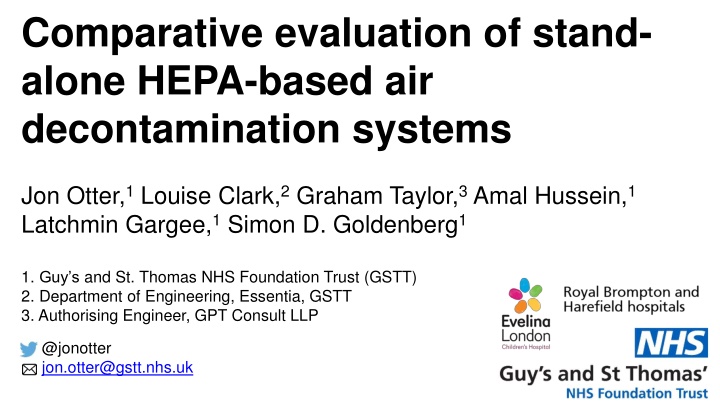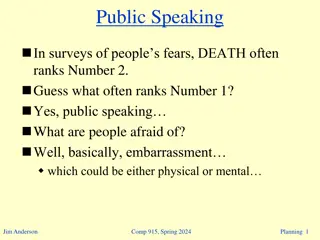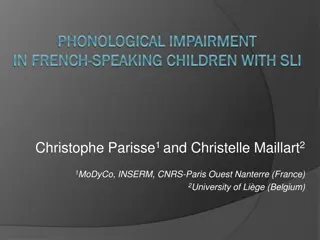Strategies for Effective Online Speaking
Strategies and challenges of online speaking, adapting to online delivery, engaging an online audience, and adjusting verbal and nonverbal communication. Understand the differences between face-to-face and online speaking, synchronous vs. asynchronous communication, and more.
Download Presentation

Please find below an Image/Link to download the presentation.
The content on the website is provided AS IS for your information and personal use only. It may not be sold, licensed, or shared on other websites without obtaining consent from the author.If you encounter any issues during the download, it is possible that the publisher has removed the file from their server.
You are allowed to download the files provided on this website for personal or commercial use, subject to the condition that they are used lawfully. All files are the property of their respective owners.
The content on the website is provided AS IS for your information and personal use only. It may not be sold, licensed, or shared on other websites without obtaining consent from the author.
E N D
Presentation Transcript
Comparative evaluation of stand- alone HEPA-based air decontamination systems Jon Otter,1 Louise Clark,2 Graham Taylor,3 Amal Hussein,1 Latchmin Gargee,1 Simon D. Goldenberg1 1. Guy s and St. Thomas NHS Foundation Trust (GSTT) 2. Department of Engineering, Essentia, GSTT 3. Authorising Engineer, GPT Consult LLP @jonotter jon.otter@gstt.nhs.uk
Introduction Contaminated air can be a vector for the transmission of key hospital pathogens, including respiratory viruses such as SARS-CoV-2. Ventilation in healthcare buildings frequently falls below minimum standards. Key pathogens can be identified in hospital air, in a range of particle sizes (e.g. Influenza, MERS, and SARS (including COVID-19)).1,2 Also, pathogens not traditionally associated with contamination of the air can be found in the air (e.g. C. difficile, Acinetobacter and MRSA).3-4 The latest UK hospital guidance for SARS-CoV-2 and other respiratory viruses includes a recommendation to consider alternative technologies to improve air hygiene when ventilation is considered inadequate or cannot be assessed. We evaluated HEPA-based stand-alone air decontamination systems, which offer the potential to reduce risk associated with contaminated air in hospitals, especially where ventilation is inadequate. 3. Munoz-Price et al. Crit Care Med 2013; 41: 1915-8. 4. Best et al. Clin Infect Dis 2010; 50: 1450-7. 1. Otter et al. J Hosp Infect 2016; 92: 235-50. 2. Bischoff et al. J Infect Dis 2013; 207: 1037-46.
Methods We undertook a structured evaluation of the technical specification of HEPA-based air disinfection systems currently available on the UK market in order to establish the range of manufacturer claims on unit specification and performance. We selected four units for further testing that were HEPA only (without UV) and had sufficient manufacturer-claimed airflow rate to achieve a theoretical 6 air changes per hour in a typical single room. The units were tested to measure: Airflow rate, noise level, the ability to remove smoke, impact on particle count, bacteria in the air, and a structured engineering review of the unit to include ease of use and maintenance. Testing was undertaken at 3 different speed settings for each unit highest, lowest, and somewhere in the middle. Testing was undertaken in an unoccupied 38m3 single hospital room, with a bed and other furniture and equipment to represent a typical hospital room. Three airflow levels in the room were tested for each device 12, 6, and 0 air changes per hour.
Overview of manufacturer data Unit A Up to 600 Unit B 300-560 Unit C 37-433 Unit D 1960 Airflow m3/hour 14 kg 40x40x67 H14 22-66 90 18 kg 84x43x43 H13 45-59 160-220 15 kg 72x34x35 H14 16-54 4-55 Weight Size HxWxD cm HEPA Noise dBA Power usage W 105x39x59 H14 58 30-150
Results noise and airflow Noise was measured at the centre of the room at 1m height; background noise with the units switched off was 33 dBA. Unit Speed setting Air volume m3/hr Noise DB(a) Unit A Med. 425 42 Unit B Med. 356 55 Unit C Med. 130 34 Unit D Med. - 58 Low 317 39 High 623 50 Low 277 51 High 439 61 Low 29 34 High 472 56 Low - 51 High - 71 Unit A Up to 600 Unit B 300-560 Unit C 37-433 Unit D 1960 Airflow m3/hour 14 kg 40x40x67 H14 22-66 90 18 kg 84x43x43 H13 45-59 160-220 15 kg 72x34x35 H14 16-54 4-55 Weight Size HxWxD cm HEPA Noise dBA Power usage W 105x39x59 H14 58 30-150
Results particle count context www.sentra.com
Results particle count context cleanrooms standards www.sentra.com
Results particle counts 0.3 micron particles (Unit D) 8000000 7000000 6000000 5000000 4000000 3000000 2000000 1000000 0 Off Low Med High 0 room ACH 6 room ACH 12 room ACH
Results particle counts 0.5 micron particles (Unit D) 800000 700000 600000 500000 400000 300000 200000 100000 0 Off Low Med High 0 room ACH 6 room ACH 12 room ACH
Results summary All the machines were easy to clean/decontaminate and change the HEPA filters. Measured airflow volumes from the units broadly matched that of the manufactures stated airflow volumes. All units tested were not able to meet the noise requirements set out within current guidance when operating at higher airflow rates. The grid readings were found to be inconsistent throughout the room with temperature in the room affecting the buoyancy of the air, and the Coanda effect (air entraining to the walls and ceiling) which was evident from the smoke visualisation. Room ventilation impacted on unit performance. Air sampling for bacteria identified a very low level of contamination at baseline.
Discussion (well, limitations and questions) How do we analyse and interpret engineering data (e.g. particle count, airflow) in the context of HCAI risk? How quiet is quiet enough? And what would patients think of this approach? Does it matter that smoke wasn t removed from every corner of the room? How do we get engineering and engineering contracts and infection specialists to speak the same language? How many stand-alone units do you need to improve air hygiene? How much of a factor is cost (unit price for the four units evaluated varied from 500 to 3,500)? Which is more important background ventilation or stand-alone unit performance?
Conclusions and next steps Our technical specification review narrowed down the wide range of options to those systems that are likely to deliver a meaningful improvement in air hygiene in hospital rooms. Comparative evaluation of the devices using standardised methods provides useful data to inform decisions about unit selection. The noise levels that we measured were higher than permitted noise levels in hospital wards (35 dBA, HTM-03). Further testing is planned to include more units including different designs, in a range of room sizes, and including microbiological air and surface sampling in occupied rooms.
Comparative evaluation of stand- alone HEPA-based air decontamination systems Jon Otter,1 Louise Clark,2 Graham Taylor,3 Amal Hussein,1 Latchmin Gargee,1 Simon Goldenberg1 1. Guy s and St. Thomas NHS Foundation Trust (GSTT) 2. Department of Engineering, Essentia, GSTT 3. Authorising Engineer, GPT Consult LLP @jonotter jon.otter@gstt.nhs.uk























